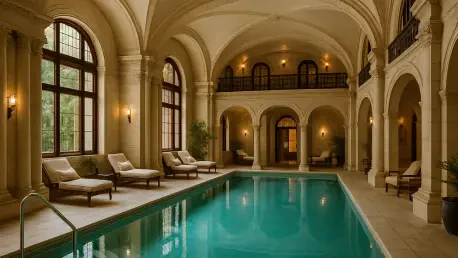Imagine stepping into a grand, historic hotel where the echoes of a bygone era meet the cutting-edge allure of modern wellness, creating a unique blend of heritage and luxury that is gaining traction in the hospitality industry. This captivating promise is exemplified by The Grand Brighton, an iconic UK establishment often dubbed the ‘Palace By The Sea,’ which has recently completed a £17 million refurbishment, spotlighting a new spa partnership that could set a new standard for luxury travel. This roundup explores diverse perspectives from industry insiders, travelers, and hospitality experts on whether historic hotels can truly redefine luxury through innovative spa offerings, using this landmark transformation as a focal point. The aim is to uncover insights, challenges, and opportunities in merging timeless elegance with contemporary wellness demands.
Perspectives on Heritage Meeting Modern Wellness
Industry Views on a Historic Transformation
Hospitality leaders have expressed enthusiasm about the potential for historic hotels to reinvent themselves through modern amenities like spas. Many emphasize that a £17 million investment, as seen with The Grand Brighton, reflects a broader shift toward creating holistic guest experiences. The launch of the L.RAPHAEL Beauty Spa & Wellness, spanning 699 square meters with features like hydrotherapy pools and advanced gym equipment, is often cited as a bold step in this direction.
Some industry voices highlight the strategic importance of partnerships with globally recognized wellness brands. Such collaborations are seen as a way to attract discerning travelers who seek both history and health-focused luxury. However, there’s a note of caution about ensuring that these modern additions don’t overshadow the architectural and cultural significance that define historic properties.
A contrasting opinion within the sector warns of the financial risks involved. High-end refurbishments and spa developments require substantial capital, and there’s uncertainty about whether the return on investment will match the growing expectations of luxury travelers. This perspective urges hotels to balance innovation with the preservation of their unique identity.
Traveler Opinions on Spa-Driven Luxury
Travelers who prioritize wellness in their journeys have shared mixed reactions to the integration of spas in historic settings. Many appreciate the idea of unwinding in a state-of-the-art facility after exploring a hotel steeped in history. The tailored offerings at The Grand Brighton, including rejuvenating treatments and health-conscious dining options, are often praised as meeting the needs of today’s health-aware guests.
On the other hand, a segment of travelers expresses concern that such modernizations might dilute the authentic charm of historic venues. For some, the appeal lies in the untouched elegance of old-world architecture, and they fear that cutting-edge spas could create a disconnect from the original allure. This viewpoint underscores the challenge of catering to diverse guest expectations.
Interestingly, feedback on exclusive membership programs, like the £1,600 annual package offering unlimited thermal suite access and special discounts, reveals a divide. While some see it as a valuable perk enhancing loyalty, others question whether it alienates casual visitors who may feel excluded from the full luxury experience.
Design Experts Weigh In on Seamless Integration
Professionals in hotel design stress the critical role of aesthetics in blending heritage with modernity. The award-winning interiors at The Grand Brighton, crafted to ensure a flow of calm from the spa to the renovated 205 bedrooms, are often highlighted as a model of thoughtful design. A £2.5 million investment specifically for the spa demonstrates the commitment to creating a cohesive sanctuary.
Many in this field argue that design must serve as a bridge between past and present, ensuring that contemporary elements feel like a natural extension of historic spaces. They point to the importance of subtle details, such as color schemes and materials, that echo the property’s legacy while introducing a sense of modern tranquility.
However, there’s a differing opinion that challenges the assumption that design alone can resolve tensions between old and new. Some suggest that without a clear narrative tying the spa to the hotel’s history, guests might perceive the addition as a superficial trend rather than a meaningful evolution. This insight calls for deeper storytelling in such transformations.
Challenges and Opportunities in Luxury Redefinition
Balancing Tradition with Innovation
A common theme among hospitality analysts is the delicate balance required when introducing modern wellness facilities into historic hotels. The consensus leans toward the idea that properties like The Grand Brighton can set a precedent by prioritizing guest-centric experiences without compromising their storied past. The partnership with a renowned skincare and wellness brand is often seen as a way to achieve this equilibrium.
Yet, there’s a notable concern about the risk of alienating traditional guests who are drawn to the historical ambiance over contemporary perks. Analysts suggest that hotels must carefully curate their offerings to ensure that both demographics feel valued, perhaps by maintaining distinct spaces for heritage-focused and wellness-focused experiences.
An opportunity identified by many is the potential to position such transformations as a competitive edge in the luxury market. By offering unique amenities that cater to the growing demand for holistic travel, historic hotels could attract a broader clientele, from wellness enthusiasts to history buffs, creating a dynamic guest base.
Setting a Precedent for Global Historic Properties
Insights from global hospitality consultants reveal optimism about the ripple effect of such initiatives. The successful integration of a high-end spa in a historic UK hotel is viewed as a blueprint that could inspire similar projects worldwide. Many believe this trend will encourage other properties to explore innovative partnerships and investments over the next few years, from 2025 onward.
A differing perspective cautions against a one-size-fits-all approach, noting that cultural and regional differences play a significant role in how luxury is perceived. What works in a seaside UK destination might not resonate in other historic contexts, prompting a call for localized strategies in wellness integration.
There’s also a forward-looking suggestion that historic hotels could leverage technology alongside wellness to further enhance guest experiences. Ideas like personalized spa treatments based on digital health profiles are floated as potential next steps, hinting at a future where tradition and innovation intersect even more deeply.
Key Takeaways from Diverse Voices
Reflecting on the varied opinions gathered, it’s evident that the transformation of historic hotels through modern spa offerings sparks both excitement and debate among stakeholders. Industry leaders celebrate the bold investments and partnerships that elevate guest experiences, while travelers offer nuanced views on balancing heritage with contemporary luxury. Design experts and analysts underscore the importance of thoughtful integration and the potential for global inspiration, even as they acknowledge challenges in meeting diverse expectations. For those intrigued by this evolving landscape, exploring other historic properties undergoing similar reinventions or delving into hospitality trend reports could provide deeper understanding and spark further ideas for enhancing luxury travel.









